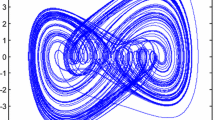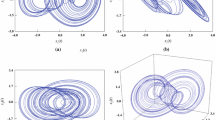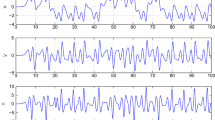Abstract
In chemical reactions, not all the reactants interact immediately, and thus, there is a need to predict the critical point of a chemical reaction. In this paper, a new fractional-order Willamowski–R\(\ddot{o}\)ssler chemical system is studied to predict the critical point in the chemical reaction. Consequently, the existence of chaotic or non-equilibrium phenomenon in the proposed chemical system is confirmed. Also, the reaction ratio of the reactants in this chemical system is investigated. In addition, the necessary conditions are derived to synchronize two identical chemical systems by designing and applying sliding mode control. Further, we have shown that the proposed synchronization technique is faster than the existing synchronization technique by comparing sliding mode controller. In application point of view, the described fractional-order chemical system is applied for image enhancement technique. Finally, numerical simulations are provided to validate the effectiveness of the proposed theoretical approach.











Similar content being viewed by others
References
Aghababa MP (2015) Design of hierarchical terminal sliding mode control scheme for fractional-order systems. Sci, Measure Technol, IET 9(1):122–133
Balasubramaniam P, Muthukumar P, Ratnavelu K (2015) Theoretical and practical applications of fuzzy fractional integral sliding mode control for fractional-order dynamical system. Nonlinear Dyn 80(1–2):249–267
Bodale I, Oancea VA (2015) Chaos control for willamowski-rössler model of chemical reactions. Chaos, Solit & Fractals 78:1–9
Caputo M (1967) Linear models of dissipation whose q is almost frequency independent-ii. Geophys J Int 13(5):529–539
Chen S and Zhao F (2016) The algorithm of fog-degraded traffic images enhancement based on fractional differential. 2016 IEEE Advanced Information Management, Communicates,Electronic and Automation Control Conference, pages 1949–1954
Chen Y, Wei Y, Zhong H, Wang Y (2016) Sliding mode control with a second-order switching law for a class of nonlinear fractional order systems. Nonlinear Dyn 50:1–11
Delavari H, Lanusse P, Sabatier J (2013) Fractional order controller design for a flexible link manipulator robot. Asian J Control 15(3):783–795
Ding Y, Wang Z, Ye H (2012) Optimal control of a fractional-order hiv-immune system with memory. IEEE Trans Control Syst Technol 20(3):763–769
El-Misiery A, Ahmed E (2006) On a fractional model for earthquakes. Appl Math Comput 178(2):207–211
Epstein IR, Showalter K (1996) Nonlinear chemical dynamics: oscillations, patterns, and chaos. J Phys Chem 100(31):13132–13147
Fatoorehchi H, Abolghasemi H, Zarghami R, Rach R (2015) Feedback control strategies for a cerium-catalyzed belousov-zhabotinsky chemical reaction system. Can J Chem Eng 92:1212–1221
Garg V, Singh K (2012) An improved grunwald-letnikov fractional differential mask for image texture enhancement. Int J Adv Computer Sci Appl 3(3):130–135
Geysermans P, Nicolis G (1993) Thermodynamic fluctuations and chemical chaos in a well-stirred reactor: a master equation analysis. J Chem Phys 99(11):8964–8969
Huang Y, Yang X-S (2005) Chaoticity of some chemical attractors: a computer assisted proof. J Math Chem 38(1):107–117
Izaguirre-Espinosa C, Muñoz-Vázquez AJ, Sánchez-Orta A, Parra-Vega V, Castillo P (2016) Attitude control of quadrotors based on fractional sliding modes: theory and experiments. IET Control Theory Appl 10(7):825–832
Lin T-C, Lee T-Y (2011) Chaos synchronization of uncertain fractional-order chaotic systems with time delay based on adaptive fuzzy sliding mode control. IEEE Trans Fuzzy Syst 19(4):623–635
Matignon D (1996) Stability results for fractional differential equations with applications to control processing. Comput Eng Syst Appl 2:963–968
Muthukumar P, Balasubramaniam P, Ratnavelu K (2014) Synchronization and an application of a novel fractional order king cobra chaotic system. Chaos: Interdiscip J Nonlinear Sci 24(3):033105
Muthukumar P, Balasubramaniam P, Ratnavelu K (2015) Sliding mode control design for synchronization of fractional order chaotic systems and its application to a new cryptosystem. Int J Dyn Control 5:1–9
Niu H, Zhang Q, Zhang Y (2002) The chaos synchronization of a singular chemical model and a williamowski-rossler model. Int J Inf Syst Sci 6(4):355–364
Poland D (1993) Cooperative catalysis and chemical chaos: a chemical model for the lorenz equations. Phys D: Nonlinear Phenom 65(1):86–99
Rajagopal K, Karthikeyan A (2016) Chaos suppression of fractional order willamowski-rössler chemical system and its synchronization using sliding mode control. Nonlinear Eng 5(3):177–183
Srivastava R, Srivastava P, Chattopadhyay J (2013) Chaos in a chemical system. Eur Phys J Special Top 222(3–4):777–783
Tavazoei MS, Haeri M (2007) A necessary condition for double scroll attractor existence in fractional-order systems. Phys Lett A 367(1):102–113
Tékam GO, Kwuimy CK, Woafo P (2015) Analysis of tristable energy harvesting system having fractional order viscoelastic material. Chaos: Interdiscip J Nonlinear Sci 25(1):013112
Vadim IU (1977) Survey paper variable structure systems with sliding modes. IEEE Trans Autom Control 22(2):212–222
Wang H, Li Q-S (2000) Microscopic dynamics of deterministic chemical chaos. J Phys Chem A 104(3):472–475
Xu C, Wu Y (2015) Bifurcation and control of chaos in a chemical system. Appl Math Modell 39(8):2295–2310
Xu C-J, Wu Y-S (2014) Chaos control of a chemical chaotic system via time-delayed feedback control method. Int J Autom Comput 11(4):392–398
Yawei L (2010) Remote sensing image enhancement based on fractional differential. 2012 Fourth International Conference on Computational and Information Sciences, pages 881–884
Acknowledgements
This work is supported by NFSC, UGC, New Delhi, File No. 82-1/2018 (SA-III), UGC-Ref. No.: 4071/ (CSIR-UGC NET JUNE 2018).
Author information
Authors and Affiliations
Corresponding author
Additional information
Publisher's Note
Springer Nature remains neutral with regard to jurisdictional claims in published maps and institutional affiliations.
Rights and permissions
About this article
Cite this article
Muthukumar, P., Babu, N.R. & Balasubramaniam, P. Detecting Critical Point of Fractional-Order Chemical System with Synchronization and Application to Image Enhancement Technique. Proc. Natl. Acad. Sci., India, Sect. A Phys. Sci. 91, 661–674 (2021). https://doi.org/10.1007/s40010-021-00763-8
Received:
Revised:
Accepted:
Published:
Issue Date:
DOI: https://doi.org/10.1007/s40010-021-00763-8




